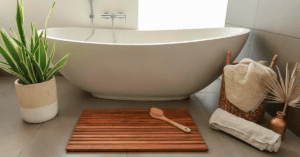Teak wood is a good material for cooking utensils. However, you may wonder: what makes teak wood safe for cooking purposes? Read on as I answer this question and more below!
When I think about wooden cooking utensils, the first hardwood that comes to mind is bamboo. But upon further research, I discovered that many hardwood species also make durable utensils, including teak.
In this post, you will learn which woods are best for cooking utensils, whether or not they are food safe, and how teak wood performs as a utensil material.
What Is the Best Wood for Kitchen Utensils?
The best wood for kitchen utensils must be strong and durable. It should withstand high temperatures during cooking. It must also not twist or warp easily when exposed to water during regular washing.
Another essential feature to consider for wooden cooking utensils is a tight grain. It must be less porous to minimize food and water penetrating the wood.
At the same time, a good grain density can eliminate bacteria on the surface of wood utensils. Therefore, it prevents the growth of these organisms and ensures your safety.
With these factors in mind, I have concluded that hardwoods are the best choice for cooking tools. These types of woods have higher durability, finer grain, and less porosity than softwoods. Thus, they are ideal for use in the kitchen.
Popular hardwoods come from deciduous trees, such as teak, mahogany, and oak. Look for these materials when purchasing a new kitchen utensil—a spoon and fork, for instance.
Avoid softwood trees like redwood, pine, spruce, and yew because they have a lower density than hardwood species. That simply means they easily break or bend when exposed to high heat and other harsh conditions during cooking.
How to Choose the Best Wood for Kitchen Utensils?
Wooden utensils can either make your kitchen tasks easier or very complicated, resulting in a complete mess.
Thus, it is essential to buy the correct type of wood. Otherwise, a bad choice of wood may result in a regrettable purchasing decision. It can also lead to animosity towards wooden spoons and utensils in general, so choose wisely.
Below, I will discuss the factors to consider before buying wood kitchen utensils.
Wood Type
One of the first factors to consider when buying a wooden spoon or utensils is the wood type.
Invest in hardwoods that come from deciduous trees. Consider teak wood for its natural water and heat resistance. You can also expect this material to last you for many years.
Other wooden tools worth considering include black walnut, cherry, mahogany, and maple. These are highly durable and can withstand hot cooking temperatures.
Avoid buying utensils made of softwood. This type of wood tends to absorb many liquids and oils. It is also soft and bendable, which is unsuitable for cooking.
Wood Grain
Besides the wood type, it is also best to look for the grain. It describes the appearance and texture of wood fibers.
Make sure you purchase utensils made of hardwood with a fine and dense grain. This product has the least porosity. It can help prevent liquids and chemicals from completely absorbing into the wood. Thus, a hardwood utensil can last several years with little to no stains.
Durability
This factor is another important consideration when choosing wooden utensils.
Look for durable wood spoons and forks that do not bend under pressure. Again, it is best to get utensils made from hardwoods.
These types of wooden utensils tend to last longer and resist water better than softwoods. They also prevent rot and bacteria growth due to their high natural oil content.
Size
Wooden utensils come in different sizes to suit various cooking uses. Therefore, it is best to consider the sizing of the product.
Look for a set that offers the size you prefer. Some homeowners like long spatulas and spoons, while others prefer short cutlery.
Regardless of your preference, you will likely find a wood kitchen utensil of the right size.
Cost
The last factor to consider before buying wooden cutlery is the price tag.
Note that expensive wood knives and forks are not necessarily the best products on the market. You might be surprised to discover that some cheaper utensils might perform better.
Hence, it is essential to find your desired features first. Then, choose an affordable deal based on those factors.
Is Teak Wood Good for Cooking Utensils?
Yes, teak is one of the best tropical hardwood materials to use for cooking utensils.
This timber is popular for its water-resistant and hard-wearing properties. In fact, teak has a hardness rating between 1,155 and 3,000 lbf (pound-force) based on the Janka scale. The higher the number, the better resilience against dents and wear. Thus, teak wood utensils can easily withstand abrasion and cracks while cooking.
Teak also contains a high concentration of natural oils. Known as teak tree oil (which is different from teak oil finish), it protects wood utensils from decay, stains, and water damage. It ultimately ensures a longer product lifespan.
Is Teak Wood Safe for Cooking?
Teak wooden utensils are safe to use for cooking applications.
This tropical hardwood is naturally oily to protect wooden spoons and forks from various elements. It does not require chemicals, lacquers, or dyes to enhance the surface. Therefore, no toxic substances can seep into your food as you cook or eat with a teak wooden utensil set.
Additionally, teak wooden utensils do not react with the acid in food. They prevent chemical leaks to ensure safe cooking. Unfortunately, the same does not apply to some plastic and metal spoons. They tend to leach harmful chemicals when they come into contact with food.
Furthermore, teak wood is food-safe because it has antimicrobial properties. Its tight wood grain can obstruct water, which bacteria need to grow. Overall, it prevents germs and other harmful organisms from developing quickly.
Why Should You Use Teak Wood For Your Cooking Utensils?
There are several reasons to use teak wood cooking utensils beside being food-safe.
First, teak hardwoods are highly durable. They do not bend or crack when exposed to high temperatures, which are common while cooking. But unlike metal utensils which conduct heat, wooden cutlery do not transfer this heat. Thus, they prevent you from accidentally burning or injuring yourself.
Additionally, teak wooden utensils do not leave scratches on expensive cookware. The same could not be said for plastic and metal spoons and forks. They can scratch nonstick cookware, eventually exposing its underlying metal. As such, teak cutlery is ideal for recipes that require occasional scraping, such as pan sauces.
Moreover, teak wood is versatile. It is suitable for making wooden spoons, forks, knives, spatulas, and even cutting boards.
Plus, teak wood cutlery is easy to hold and stir while cooking. It can conform to your hand’s shape for a more comfortable experience.
On top of all these benefits, teak cooking utensils have a distinct golden brown color. Together with their fine texture, they make for an attractive sight in your kitchen. Most products are also handcrafted to ensure a personalized touch. They are ultimately excellent gift ideas.
How Do You Take Care Of Teak Cooking Utensils?
Teak kitchen utensils do not require as much maintenance as other kinds of timber.
The reason is teak’s natural oil finish. It protects the wood surface from harsh chemicals and usage. It is also insect- and water-resistant.
That said, teak wood utensils undergo regular hand washing during their lifetime. As such, soapy water can eventually strip off these natural-occurring teak wood oils.
If you want to take care of teak utensils, consider oiling them every four to six months. You must also regularly check the teak wood’s condition. That means being on the constant lookout for cracks or splits. If you encounter these types of damages, you will need to apply oil finishes more frequently.
You will likely come across two types of wood oils—drying and non-drying. The former is exactly as it sounds; it can dry into a hard coat. In contrast, non-drying oils never become dry and cured. Instead, they remain slick to the touch and difficult to wash off.
Regardless of your choice, ensure the wood oil finish is food-safe. Check the ingredients to see if they do not include harmful substances. Or contact the manufacturer to guarantee its safe use around food products.
Frequently Asked Questions
Is teak wood toxic to humans?
Teak wood as sawdust is a sensitizer. It refers to chemicals that cause allergic skin reactions and respiratory problems. So in sawdust form, teak can potentially harm humans.
However, there is no need to worry. You may wonder: why? Well, most hardwood sawdust can cause similar reactions in users when inhaled or touched.
Fortunately, in its natural solid, teak wood is perfectly safe around food. In fact, it is among the best materials for wooden kitchen cutlery. Unlike some plastic and metal cooking utensils, it does not negatively react when coming into direct contact with food.
Teak also kills harmful bacteria, thanks to its tight wood grain. The same could not be said for other wooden utensils, which tend to have larger pores. These eventually cause leftover food to settle in the grain, leading to bacteria growth.
Can you oil wooden cooking utensils?
You can apply oil finishes to your teak wooden cooking utensils. Doing so yields several benefits.
First, wood oils can enhance the grain. They can seal in natural teak oils to protect from heat and water damage.
Additionally, wood oil can restore the vibrant golden shade of teak. It can keep it beautiful for years to come.
Finally, it extends the lifespan of teak kitchen utensils.
However, remember that some wood oils are toxic and non-food-safe. Ensure to read the product label and ingredients before buying them. Only use food-grade oil to maintain your wooden utensils.
How to prevent stains on teak wooden utensils?
Teak kitchen utensils often have direct contact with food. Therefore, they are susceptible to stains and discoloration.
Fortunately, it is relatively easy to prevent stains on wooden cutlery. All you need to do is wash teak spoons and forks right after use. You can use warm water and mild dishwashing liquid for this task. But you can also consider salt and lemon juice to remove stubborn stains.
Conclusion
Solid teak wood is one of the best materials for cooking utensils. It contains pure teak oils that withstand decay, heat, and moisture. Teak wood cutlery also does not leave scratches and stains on your cookware. Furthermore, teak tends to last longer than other hardwoods. It still requires occasional maintenance, but it is easy to use food-grade oils for regular care. Ultimately, teak wood is safe to use for cooking.






